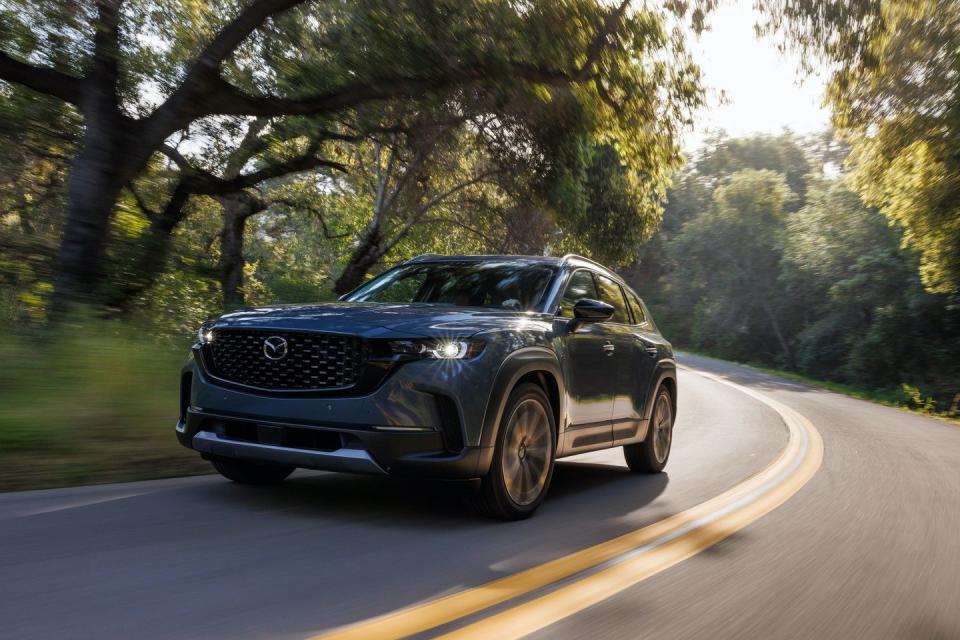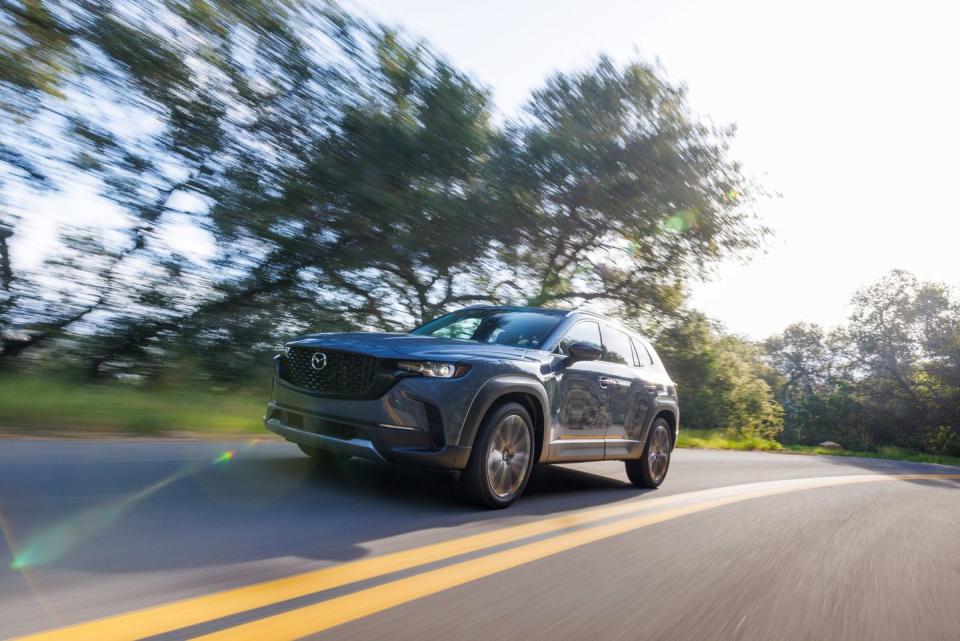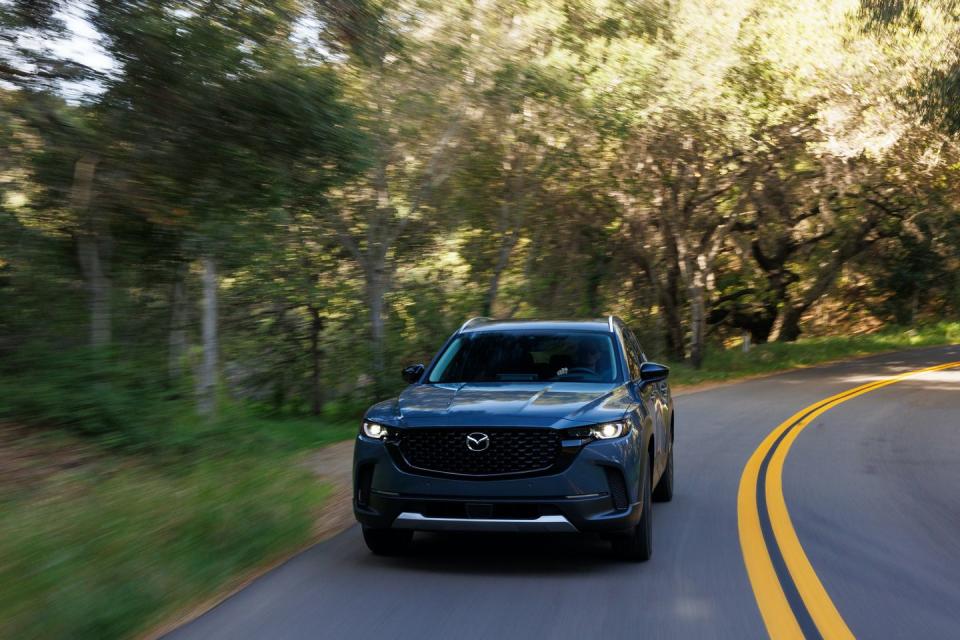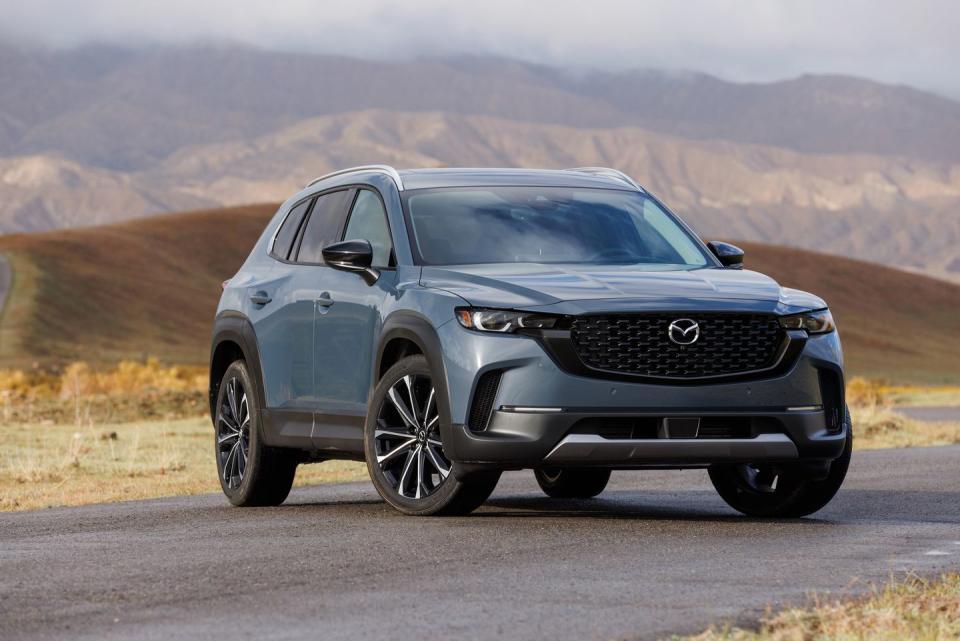The 2023 Mazda CX-50 Is a Better Subaru Outback

The striking thing about the new 2023 Mazda CX-50 is what it lacks. While others obsess over graphic interfaces and ever-wider, ever-taller screens filled with layer after layer of inscrutable menus, sub-menus and haptic feedback sensations, Mazda has stuck with throwback interior motifs.
Instrumentation that looks like instrumentation. Straightforward controls. And displays that keep the driver’s eyes up and focused on the road. It’s almost like Mazda still believes in driving.
That’s the third-best thing about this new crossover.
The mechanical substance is old-school, too. It’s not a hybrid. Not all-electric. It has but one conventional 12-volt battery that has the important duty of starting either of the available four-cylinder internal combustion engines—one turbocharged, one breathing in atmosphere unassisted. That’s the second-best thing about this new crossover.
The best thing is the handling.

Mazda has had the CX-5 in the compact crossover segment since the 2013 model year; we've seen two generations of that vehicle. But the CX-50 doesn’t replace the CX-5, and it isn’t ten times better, no matter what the number promises. Why Mazda needs two vehicles so close to one another in specification and name is a mystery inside a riddle wrapped up in marketing segmentation.
One distinction between the CX-5 and CX-50 is where they are built. The CX-5 comes out of Mazda’s well-aged, stalwart plant in Hiroshima, Japan, while the CX-50 is being built at the new Mazda-Toyota Manufacturing USA facility in Huntsville, Alabama. The Toyota side of that plant is making the Corolla Cross, but that vehicle and the CX-50 are otherwise unrelated. Mazda explains that while some production processes, like paint, are shared, there are no common parts between the two.

The CX-50 is larger than the CX-5 in every dimension. At 185.8 inches long overall, it stretches out 5.7 inches longer than its older brother, and its 110.8-inch wheelbase is 4.6 inches longer. But the most significant size difference is in width. The CX-50, built in North America for the North American avoirdupois (and in a newer plant that allows it—Mazda explains that the aging Hiroshima plant can’t take wider vehicles), goes 75.6 inches with the mirrors tucked in. That’s up three inches on the CX-5. And with its broader grille and flatter plane surfaces, it looks even wider than that.
Under that sheet steel is the same basic suspension design and structure used by the CX-3 and the new MX-30 EV that’s currently only available in California, taffy-pulled to the new vehicle's dimensions. And considering the variations already available, it will be flexible enough to accommodate the upcoming hybrid version and, possibly, some sort of electric variant too.
But that’s the future. Right now the CX-50 is offered with the two four-cylinders mentioned, either one backed by a six-speed automatic transmission that feeds a full-time all-wheel drive system. The base engine is the Skyactiv-G 2.5-liter naturally aspirated unit, rated at 187 horsepower—essentially the same engine used in the CX-5, and likely adequate. The upgrade drivetrain is that 2.5-liter with the addition of a twin-scroll turbocharger that thumps horsepower up to 227. More impressively, the turbo makes 320 lb-ft of peak torque at 2500 rpm when running on 93-octane gasoline. The best the non-turbo can manage is 186 lb-ft at 4000 rpm.

Mazda has aimed the CX-50 squarely at the Subaru Outback. The Outback is longer at 191.3 inches, but runs a 2.7 inch shorter wheelbase. Both automakers like to brag about generous ground clearance (8.6 inches for the Mazda, a tenth more for the Subie) and approach angles (18 degrees for the CX-50, 18.6 for the Outback). They offer similar accommodations inside and standard all-wheel drive. But the most telling indication that Mazda is aiming at the Outback comes from Google. Type in "Subaru Outback," and the first result is an ad for the Outback itself. Subaru pays for that. The second result is an ad Mazda bought for the CX-50. Go ahead, try it.
While the Outback’s available 2.4-liter turbocharged flat-four is rated at 260 horsepower, its torque peaks at 277 lb-ft at 2000 rpm. So the Mazda is down on horsepower but up on grunt. The guesstimate here is that the CX-50 in top turbo spec will run 0-60 in just under six seconds, nose-to-nose with the Outback. And the Outback is stuck with a CVT. Ick.

And the answer to the Subaru Outback Wilderness, the overlanding range-topper, will be a CX-50 "Meridian Edition" featuring many of the same off-roady, adventure-style elements.
During the press introduction, all the CX-50s on hand were 2.5 Turbo Premium Plus models with a starting price $42,775 after a $1225 destination charge. Running 245/45R-20 touring tires on 20-inch wheels, there was little reason to expect a vehicle with exceptional handling. But that one little reason is Dave Coleman.
As a matter of personal disclosure, Coleman is a former journalist with whom I worked at the dearly departed Sport Compact Car magazine back in the day. He’s a friend, and also a rally driver and Lemons racer. And he’s an engineer who graduated from California’s hardcore Harvey Mudd College and now Mazda’s vehicle dynamics manager. He has the CX-50 totally dialed in.

Despite the modest tires, on the open road the CX-50’s steering is immediate and responsive. The all-wheel drive system pulls cleanly through corners and it takes determined effort to do anything so stupid it would upset the vehicle. It’s not the best handling crossover ever—that honor goes to the much pricier Porsche Cayenne Turbo GT—but the fact that this relatively affordable machine is reminiscent of Porsche's standard-setting beast is astonishing. Let’s put some real tires on the CX-50 (does Michelin make a Pilot Sport in 255/40R-20 size?) and see how it compares to Porsche’s best. Or the Macan GTS. Or whatever Audi crossover is top-dog this month.
All this despite the CX-50’s simple suspension: struts up front and a torsion beam in back. Of course, there are driving modes that tweak things for sporty driving or off-road work, but it’s tough to evaluate those in the confined context of a press drive. But it was easy to sneak off to Southern California’s famed Route 33 and let this twerp tweak. It’s great on 33.

That in mind, the transmission could use some work. It’s not that it needs more gears, but it’s reluctant to manually shift down into second gear on corners where clearly it needs to be in second. It’s easy to second-guess this sort of programming. After all, Road & Track doesn’t have to worry about Mazda’s warranty claims. But more aggressive transmission mapping would add even more satisfaction to a vehicle that's clearly already among the best-handling crossovers.
So there’s a Meridian Edition coming. But where’s the Mazdaspeed CX-50 to go with it? The performance compact crossover market may be a small niche, but Mazda could totally own it with the CX-50. Sadly, Mazdaspeed saw its last sunset in 2013.

Prices for non-turbo CX-50s will start at $28,025, with the most popular models in the mid-$30,000 range and the cheapest turbo version at $37,625. That’s not cheap, but it represents solid value.
Yes, it has Apple CarPlay and Android Auto. And Mazda has added a touchscreen option for those who can’t handle the knobby thing controlling the infotainment chores. Mazdas aren’t for people who use the word "infotainment" without a little bit of sick backing up in their mouth.
The CX-50 isn’t a distraction machine. It’s an engagement generator. And we can never have enough of those.
You Might Also Like

 Yahoo Autos
Yahoo Autos 